After discussing monetization strategies last week, I thought it would be interesting to examine a high profile launch from last month that used a very unusual approach: Super Mario Run.
Mario Run is a 2D endless runner. While endless runners traditionally cater to the casual game audience, which dedicated blog readers know favor free games, Mario is a long standing franchise with appeal to both core and casual gamers. Furthermore, its top-notch art and relatively nuanced controls put it a step above most runners in the App Store. Based on what we’ve learned about monetization strategies, can you decide if this means the game should be free or paid?
Well, it seems Nintendo wasn’t sure either.
The game is clearly designed as a paid game. It has no ads or consumable in-app purchases. But it’s free. The game does make use of a relatively under-utilized monetization method, though—the non-consumable in-app purchase.
The main reason you don’t see non-consumable in-app purchases that often is because they rarely represent a revenue maximizing strategy. Most users don’t spend any money on in-app purchases regardless of the price. The 5 to 10 percent that do, however, often spend a lot. That’s why many developers like to use consumable in-app purchases to give these users an endless supply of virtual goods to buy. Nonetheless, non-consumable in-app purchases are a natural fit for paid games or ad based games that want to add extra level packs, typically after providing the player with a lot of core content. Flow Free did this successfully.
Super Mario Run took things a step further. They didn’t use a non-consumable in-app purchase for a few extra levels. They used it to lock-up substantially the whole game, otherwise known as a paywall. We’ll circle back to this shortly.
Mario has been out for over one month now, and the major news outlets have done nothing but write about its averageness. It’s rating is only 3 stars. Nintendo’s stock actually suffered on its release day, but despite the reviews, I think it’s one of the best auto-runners in the App Store, right up there with Punch Quest. A lot of other people do too. Take a look at the reviews.
It’s a barbell distribution. The reviews are mostly 1 star or 5 stars. So what’s going on? Usually when this happens, it’s because an otherwise high quality game has a technical issue that causes some portion of the users to experience crashes. They give it 1 star and everyone else rates it highly. Limbo experienced this phenomenon when it launched and didn’t work on older devices. That game has since recovered to the 4.5 star rating it deserves.
But Mario hasn’t recovered. This is something different and much more avoidable than a bug. This is a poor monetization choice: the paywall.
The theory behind the paywall is: (1) Free games do better than paid games because users don’t want to risk a dollar on a game that might be bad when there are so many free options. (2) Users would rather pay upfront for a game and avoid the freemium economy, if only they could rest assured that the game would be good. Therefore, you make the game free, give users a very small taste of the action, then make them pay to go any further.
It must have sounded like a good idea to Nintendo. Perhaps they didn’t consider that when most users reach a paywall, they don’t buy the game. They get angry, and many decide to leave a 1 star review. The worst part of this is that Nintendo already has a reputation for making great games. Most people who were willing to pay for Super Mario Run, could have rightly assumed that it would be a good game without seeing the trial content. Of all developers, Nintendo’s name recognition makes them well-positioned to release a paid game and get plenty of interest. They could have avoided the majority of the 1 star reviews, and had an overall 4.5 to 5 star rating if it was paid. The higher rating likely would have attracted even more downloads, and maximized Nintendo’s revenue from the title.
Super Mario Run was clearly designed as a paid game with no consumable in-app purchases. I suspect the success of Pokemon Go as a free game had Nintendo second guessing the paid approach, and led them to list free with a paywall. Lucky for us, they gave us a fun game and a monetization lesson at the same time!

